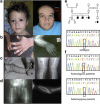Expanding the clinical spectrum of B4GALT7 deficiency: homozygous p.R270C mutation with founder effect causes Larsen of Reunion Island syndrome
- PMID: 24755949
- PMCID: PMC4266744
- DOI: 10.1038/ejhg.2014.60
Expanding the clinical spectrum of B4GALT7 deficiency: homozygous p.R270C mutation with founder effect causes Larsen of Reunion Island syndrome
Abstract
First described as a variant of Larsen syndrome in Reunion Island (LRS) in the southern Indian Ocean, 'Larsen of Reunion Island syndrome' is characterized by dwarfism, hyperlaxity, multiple dislocations and distinctive facial features. It overlaps with Desbuquois dysplasia, Larsen syndrome and spondyloepiphyseal dysplasia with dislocations ascribed to CANT1, FLNB and CHST3 mutations, respectively. We collected the samples of 22 LRS cases. After exclusion of CANT1, FLNB and CHST3 genes, an exome sequencing was performed in two affected second cousins and one unaffected sister. We identified a homozygous missense mutation in B4GALT7, NM_007255.2: c.808C>T p.(Arg270Cys) named p.R270C, in the two affected cases, not present in the unaffected sister. The same homozygous mutation was subsequently identified in the remaining 20 LRS cases. Our findings demonstrate that B4GALT7 is the causative gene for LRS. The identification of a unique homozygous mutation argues in favor of a founder effect. B4GALT7 encodes a galactosyltransferase, required for the initiation of glycoaminoglycan side chain synthesis of proteoglycans. This study expands the phenotypic spectrum of B4GALT7 mutations, initially described as responsible for the progeroid variant of Ehlers-Danlos syndrome. It further supports a common physiopathological basis involving proteoglycan synthesis in skeletal disorders with dislocations.
Figures

Similar articles
-
Further Defining the Phenotypic Spectrum of B3GAT3 Mutations and Literature Review on Linkeropathy Syndromes.Genes (Basel). 2019 Aug 21;10(9):631. doi: 10.3390/genes10090631. Genes (Basel). 2019. PMID: 31438591 Free PMC article. Review.
-
Prenatal and neonatal phenotype of Larsen of La Réunion Island syndrome (B4GALT7-linkeropathy).Eur J Med Genet. 2024 Jun;69:104940. doi: 10.1016/j.ejmg.2024.104940. Epub 2024 May 3. Eur J Med Genet. 2024. PMID: 38705458
-
Further defining the phenotypic spectrum of B4GALT7 mutations.Am J Med Genet A. 2016 Jun;170(6):1556-63. doi: 10.1002/ajmg.a.37604. Epub 2016 Mar 4. Am J Med Genet A. 2016. PMID: 26940150
-
Redefining the progeroid form of Ehlers-Danlos syndrome: report of the fourth patient with B4GALT7 deficiency and review of the literature.Am J Med Genet A. 2013 Oct;161A(10):2519-27. doi: 10.1002/ajmg.a.36128. Epub 2013 Aug 16. Am J Med Genet A. 2013. PMID: 23956117 Free PMC article. Review.
-
Phenotype and response to growth hormone therapy in siblings with B4GALT7 deficiency.Bone. 2019 Jul;124:14-21. doi: 10.1016/j.bone.2019.03.029. Epub 2019 Mar 23. Bone. 2019. PMID: 30914273 Free PMC article.
Cited by
-
Classical Galactosaemia and CDG, the N-Glycosylation Interface. A Review.JIMD Rep. 2017;34:33-42. doi: 10.1007/8904_2016_5. Epub 2016 Aug 9. JIMD Rep. 2017. PMID: 27502837 Free PMC article.
-
Further Defining the Phenotypic Spectrum of B3GAT3 Mutations and Literature Review on Linkeropathy Syndromes.Genes (Basel). 2019 Aug 21;10(9):631. doi: 10.3390/genes10090631. Genes (Basel). 2019. PMID: 31438591 Free PMC article. Review.
-
Mutant B3GALT6 in a Multiplex Family: A Dominant Variant Co-Segregated With Moderate Malformations.Front Genet. 2022 Jun 6;13:824445. doi: 10.3389/fgene.2022.824445. eCollection 2022. Front Genet. 2022. PMID: 35734427 Free PMC article.
-
Mutations in Biosynthetic Enzymes for the Protein Linker Region of Chondroitin/Dermatan/Heparan Sulfate Cause Skeletal and Skin Dysplasias.Biomed Res Int. 2015;2015:861752. doi: 10.1155/2015/861752. Epub 2015 Oct 25. Biomed Res Int. 2015. PMID: 26582078 Free PMC article. Review.
-
Novel Splicing Mutation in B3GAT3 Associated with Short Stature, GH Deficiency, Hypoglycaemia, Developmental Delay, and Multiple Congenital Anomalies.Case Rep Genet. 2017;2017:3941483. doi: 10.1155/2017/3941483. Epub 2017 Nov 28. Case Rep Genet. 2017. PMID: 29318063 Free PMC article.
References
-
- Payet G. Nanisme et hyperlaxité dysmorphie faciale et luxations multiples: syndrome de Larsen. Arch Fr Pediatr. 1975;32:601–608. - PubMed
-
- Laville JM, Lakermance P, Limouzy F. Larsen's syndrome: review of the literature and analysis of thirty-eight cases. J Pediatr Orthop. 1994;14:63–67. - PubMed
-
- Larsen LJ, Schottstaedt ER, Bost FC. Multiple congenital dislocations associated with characteristic facial abnormality. J Pediatr. 1950;37:574–581. - PubMed
-
- Harris R, Cullen CH. Autosomal dominant inheritance in Larsen's syndrome. Clin Genet. 1971;2:87–90. - PubMed
Publication types
MeSH terms
Substances
Supplementary concepts
LinkOut - more resources
Full Text Sources
Other Literature Sources
Molecular Biology Databases
Miscellaneous

